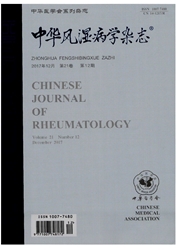

 中文摘要:
中文摘要:
目的探讨脂质和蛋白质过氧化与系统性红斑狼疮(SLE)临床指标的相关性。方法测定60例SLE患者与60名正常对照血浆中超氧化物歧化酶(SOD)的活动度、丙二醛(MDA)和蛋白质羰基的浓度,分析氧化,抗氧化指标与SLE病情活动及其他临床指标的相关性。结果狼疮病例组和健康对照组相比,SOD活动度显著降低(P〈0.01),MDA和蛋白质羰基的浓度显著升高(P〈0.01)。不同疾病活动度的SLE患者MDA、蛋白质羰基、SOD水平差异有统计学意义。机体的过氧化状态与SLE患者病程中出现的肾脏损伤和心血管病变存在一定联系。氧化航氧化指标与临床指标的相关性分析显示:氧化,抗氧化指标与抗核抗体、抗dsDNA抗体、C反应蛋白、低密度脂蛋白存在一定相关性。结论SOD活动度的降低,MDA和蛋白质羰基浓度的升高提示SLE患者处于氧化应激状态.机体过氧化状态与SLE疾病活动和临床表现显著相关。
 英文摘要:
英文摘要:
Objective To investigate the correlation between lipid peroxidation and protein oxidation with systemic lupus erythematosus (SLE). Methods The activity of plasma superoxide dismutase (SOD) and the levels of plasma malondialdehyde (MDA) and protein carbonyl were measured in 60 patients with SLE and 60 healthy controls. The correlation of oxidant/antioxidant status to SLE disease activity and other clinical parameters were analyzed. Results There was significant difference in the SOD activity in SLE group compared with the control group (P〈0.001). In addition, MDA and protein carbonyl levels were significantly higher in patients than in the controls (P〈0.001). There was significant difference in SOD activity and MDA and protein carbonyl levels in patients with different disease activity of SLE. The correlation of oxidant/antioxidant status with organ damage and clinical disease activity indicators was confirmed. Conclusion Decrease in SOD activity and the high levels of MDA and protein carbonyl indicates increased oxidative stress. Our results suggest a nossible role of oxidative stress in disease activitv and clinical sign of SLE.
 同期刊论文项目
同期刊论文项目
 同项目期刊论文
同项目期刊论文
 Fas expression on peripheral blood lymphocytes in systemic lupus erythematosus: relation to the orga
Fas expression on peripheral blood lymphocytes in systemic lupus erythematosus: relation to the orga Transforming growth factor-beta1-induced CD4+CD25+ regulatory T cells in vitro reverse and prevent a
Transforming growth factor-beta1-induced CD4+CD25+ regulatory T cells in vitro reverse and prevent a 期刊信息
期刊信息
